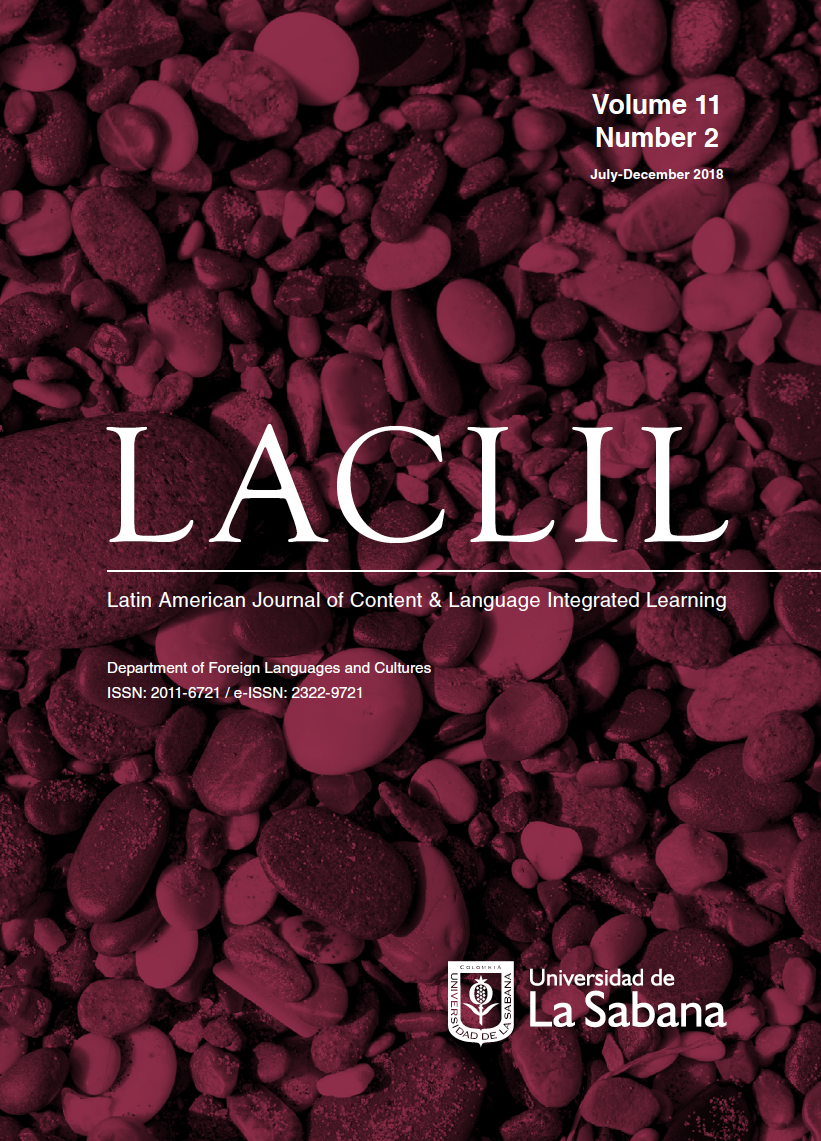Creating “Glocal” Classrooms to Promote Communication
DOI:
https://doi.org/10.5294/laclil.2018.11.2.1Keywords:
CLIL, CLIL in Turkey, CLIL in Spain, CLIL in Taiwan, ESP, CLIL Material Design,Abstract
Creación de aulas “glocales” para promover la comunicación
Criação de salas de aula “glocais” para promover a comunicação
With the globalization of human activities, it has become gradually more important to improve one’s ability to communicate in an additional language. Today, everyone needs to be able to successfully operate in an increasingly globalized world (Ke, 2015; Youssef, 2014), where new communication styles and cultural perspectives differ, allowing learners greater appreciation and understanding of cultural differences. These differences are key in helping learners adjust to various cultural scenarios that will arise throughout their lives. Thus, it is imperative that learners be prepared for the demands of working and living in an increasingly multicultural and interconnected world, and this preparation can be significantly improved by improving language learning and language instruction. By introducing learners to new cultures, historical perspectives, and ways of living and thinking, language classes (L1, L2, or L3) can offer a unique opportunity for creating “glocal” (global + local) classrooms, allowing learners to cross boarders within the confines of the educational institution...
To reference this article (APA) / Para citar este artículo (APA) / Para citar este artigo (APA)
McDougald, J. (2018). Creating “Glocal” Classrooms to Promote Communication. LACLIL, 11(2), 185-192. DOI: 10.5294/laclil.2018.11.2.1
Downloads
References
Ananyeva, M. (2014). A learning curriculum: Toward student‐driven pedagogy in the context of adult English for academic purposes, English for specific purposes, and workplace English programs. TESOL Journal, 5, 8 -31. DOI: 10.1002/tesj.73
Anderson, C. E. (2011). CLIL for CALP in the multilingual, pluricultural, globalized knowledge society: Experiences and backgrounds to L2 English usage among Latin American L1 Spanish-users. Latin American Journal of Content and Language Integrated Learning, 4(2), 51–66. DOI: 10.5294/laclil.2011.4.2.5
Coyle, D., Hood, P., & Marsh, D. (2010). CLIL: Content and language integrated learning. Cambridge, UK: Cambridge University Press.
Dalton-Puffer, C., Nikula, T., & Smit, U. (2010). ‘CLIL and Immersion Classrooms: Applied Linguistic Perspectives.’ International Journal of Applied Linguistics, 20(3), 432–433. DOI: 10.1111/j.1473-4192.2010.00271.x
Eaton, S. E. (2001). Global trends in language learning in the 21st Century 2010. Qualitative Research and Case Study Applications in Education, 27–43. Retrieved from https://eric.ed.gov/?id=ED510276
Granados, J. (2018). The challenges of higher education in the 21st century. Global University Network of Innovation. Retrieved from http://www.guninetwork.org/articles/challenges-higher-education-21st-century
Halbach, A. (2012). Questions about basic interpersonal communication skills and cognitive language proficiency. Applied Linguistics, 33(5), 608–613. DOI: 10.1093/applin/ams058
Hansen-Thomas, H., Langman, J. & Farias, T. (2018). The role of language objectives: Building math and science teachers’ language awareness with emergent bilinguals in secondary classrooms. Latin American Journal of Content & Language Integrated Learning, 11(2), 193-214. DOI: 10.5294/laclil.2018.11.2.2
Ke, I.-C. (2015). A global language without a global culture: From basic English to global English. English as a Global Language Education (EaGLE) Journal EaGLE Journal, 1(11), 65–87. DOI: 10.6294/EaGLE.2015.0101.04
Khatib, M., & Taie, M. (2016). BICS and CALP: Implications for SLA. Journal of Language Teaching and Research, 7(2), 382. DOI: 10.17507/jltr.0702.19
Ferrando, E. (2018). La enseñanza de segundas lenguas mediante contenidos históricos. Propuesta de un modelo teorico-práctico para el diseño de materiales basados en el enfoque AICLE. Latin American Journal of Content & Language Integrated Learning, 11(2), 275-307. DOI: 10.5294/laclil.2018.11.2.5
McDougald, J. S. (2016). Is CLIL becoming a hub connecting research, policy, and practice? Latin American Journal of Content & Language Integrated Learning, 9(1), 7–16. DOI: 10.5294/laclil.2016.9.1.1
Mede, E. & Çinar, S. (2018). Implementation of content and language integrated learning (CLIL) and its effects on student motivation. Latin American Journal of Content & Language Integrated Learning, 11(2), 215-235. DOI: 10.5294/laclil.2018.11.2.3
Otto, A. (2018). Assessing language in content and language integrated learning: A review of the literature towards a functional model. Latin American Journal of Content & Language Integrated Learning, 11(2), 308-325. DOI: 10.5294/laclil.2018.11.2.6
Ranney, S. (2012). Defining and teaching academic language: Developments in K-12 ESL. Linguistics and Language Compass, 6(9), 560–574. DOI: 10.1002/lnc3.354
Scott, C. L. (2015). The futures of learning 3: What kind of pedagogies for the 21st century? (Education Research and Foresight Working Papers No. 15). Paris, France: UNESCO.
Smit, U. (2007). CLIL and immersion classrooms: Applied linguistic perspectives. International Journal of Applied Linguistics, 17(2), 266–268. DOI: 10.1111/j.1473-4192.2007.154_1.x
Tatzl, D. (2011). English-medium masters’ programmes at an Austrian university of applied sciences: Attitudes, experiences and challenges. Journal of English for Academic Purposes, 10(4), 252–270. DOI: 10.1016/j.jeap.2011.08.003
Valian, V. (2015). Bilingualism and cognition. Bilingualism: Language and Cognition, 18(1), 3–24. 10.1017/S1366728914000522
Yang, W. (2018). Evaluating contextualized CLIL (Content and Language Integrated Learning) materials at tertiary level: A collaboration between ESP practitioners and learners. Latin American Journal of Content & Language Integrated Learning, 11(2), 236-274. DOI: 10.5294/laclil.2018.11.2.4
Youssef, L. (2014). Globalisation and higher education: From within-border to cross-border. Open Learning: The Journal of Open, Distance and e-Learning, 29(2), 100–115. 10.1080/02680513.2014.932686
Downloads
Published
How to Cite
Issue
Section
License
This Journal and its articles are published under the Creative Commons CC BY 4.0 DEED Attribution 4.0 International license. You are free to: Share — copy and redistribute the material in any medium or format for any purpose, even commercially. Adapt — remix, transform, and build upon the material for any purpose, even commercially. The license cannot revoke these freedoms as long as you follow the terms of the license.








